Just days before coronavirus took hold of New York City, Bryan Lovejoy boarded the Grand Princess Cruise ship off the coast of California. It was March 8, 2020, and Lovejoy was part of a team of disaster medical assistance workers embarking on what would be one of the United States’ first missions to combat the novel coronavirus SARS-CoV-2 and its related illness, Covid-19.
“At the time it was kind of surreal, you know? It was like something you’d see in a movie,” he said. “A bunch of healthcare providers going onto a ship with a novel virus… I mean, in a lot of ways, I was just happy that there were no zombies on board.”
Back then, there was very little information to work with. There were no treatments immediately available, and no clear plans on how to prevent the spread. Lovejoy and his team spent a little over 24 hours on the cruise ship screening and separating passengers. “I woke up at 7:00 AM and I didn’t get on the ship until about 6:00 PM. We went all through the night screening passengers,” he recalled. “I didn’t get off the ship until about 12 noon the next day. They took us and actually sent us to the University of Nebraska, and we were quarantined for 14 days.”
Disaster medical assistance teams are typically deployed in the event of natural disasters. Lovejoy has been a part of his team for 13 years but he’s been working in health care even longer. Ten years ago, Lovejoy met Adam Gotlieb, a fellow healthcare worker and DMAT team member, at a special security event. The pair became hit it off immediately, becoming friends as well as teammates.
Lovejoy started his career as an emergency medical technician at a local fire department at just 18 years old. There, he rose in rank from EMT to EMT-CC (critical care), while he pursued his nursing degree. Now, he holds a Doctor of Nursing Practice degree and works full-time as a nurse practitioner at Northshore University Hospital. Lovejoy spends his days on the floor treating a wide variety of patients and illnesses. His passion shines through in the field, according to Gotlieb, who has worked alongside him on multiple missions, including in Texas after Hurricane Harvey and Puerto Rico after Hurricane Maria.
“Being in [healthcare] for so long, people tend to get jaded. I’ve never seen that in Bryan,” said Gotlieb. “He’s always given 100 percent, even in the worst of times. When we were in Puerto Rico seeing 300 to 400 patients a day, he, on a normal basis, was the outperformer. He would definitely see and treat the most patients in a single day, and it never bothered him. He enjoys what he does and, I mean, it really shows.”
When Lovejoy returned from his mission on the Grand Princess, he was thrown into the fight at home during the earliest surge of cases in New York. In March of 2020, it was estimated that New York City accounted for around 5% of Coronavirus cases worldwide. In the time that Lovejoy had been gone, his professional, personal, and social life had changed drastically. New York City began implementing a PAUSE order, a 10 point policy that enforced social distancing restrictions, prohibited all non-essential gatherings, and closed all non-essential businesses in an effort to slow the spread. But, even with the order in effect, Lovejoy’s hospital was in a frenzy, and the CDC continued to fire out new information every day. In addition to the alarming number of positive cases that continued to rise every day, death was running rampant; on April 7, 2020, New York City recorded more than 800 Covid-19-related deaths in a single day.
“We were just watching people die before our eyes,“ Lovejoy said. “We didn’t have any really viable treatment, we were just trying things out. I’ve never seen anything like that before.”
21-year-old Julia Ryan started her position as a patient care associate, in July 2020, five months before the onset of the pandemic. She decided to join the healthcare system to gain some hands-on experience as she works toward her nursing degree. Ryan plays a central role in nursing her patients back to health by tending to their most basic needs, such as charting their vital signs, feeding them, and sometimes even bathing them. She, like many others, didn’t expect to be on the frontlines in the fight against Covid-19.
“It was like they get in the bed, they die, they get in the bed, they die,” Ryan said. “It was the quietest I’ve ever seen the floor, ’cause none of them could talk. They [the patients on her unit] all had non-rebreather masks on, they were all laying flat or in the prone position. They were watching people die from Covid and they’re just sitting in bed.”
Fear wasn’t just in the hospital beds—it was the connecting factor among many healthcare professionals, a kind of collective worry.
“It was just like you’re constantly afraid that you could get it,” said Lovejoy. ”You had to kind of keep your emotions in check because, you know, your children want to hug you and you can’t even hug them until you’re showered. Even then you’re not sure if you got exposed or infected. There were just a lot of psychological fear factors.”
According to the University of Utah, more than 50% of pandemic era healthcare workers are at risk for developing mental health conditions, such as acute traumatic stress, depression, anxiety, problematic alcohol use, and insomnia. Their study found that healthcare professionals that were exposed to, or at greater risk of contracting Covid-19, are also now at higher risk of developing mental health disorders. A 2016 study found that “occupational burnout” was a prevalent issue amongst healthcare workers treating HIV/AIDS epidemic in China.
Fear lingered around Lovejoy for months. It was present every day until he received his vaccine. Now, he advocates for immunization. He firmly believes that any chance that we have at defeating coronavirus lies in the vial, but it seems that many are still on the fence. To that, he says that there is no shame in being a skeptic.
“I read like probably 10 articles before I went in there, and I still had a level of fear or anxiety when getting it,” he said. “The science is definitely very sound that it’s really effective, and it’s really our only way to the end of this pandemic. This is the best tool we have—preventive medicine.”
Even with the lower case numbers and the increase in vaccine availability, Lovejoy says that the fight against Covid-19 is far from over.
“I mean, there’s just so many layers of it, you know?” He said, ” and that’s that’s what’s so insidious about it it just goes on and on. A lot of times if you’re dealing with traumatic experiences, you at least have a relief period in the middle where you can kind of recover, get past it, try to get over it. I think for a lot of us it’s still going. It hasn’t ended yet. So, until it ends we can’t really move forward.”


